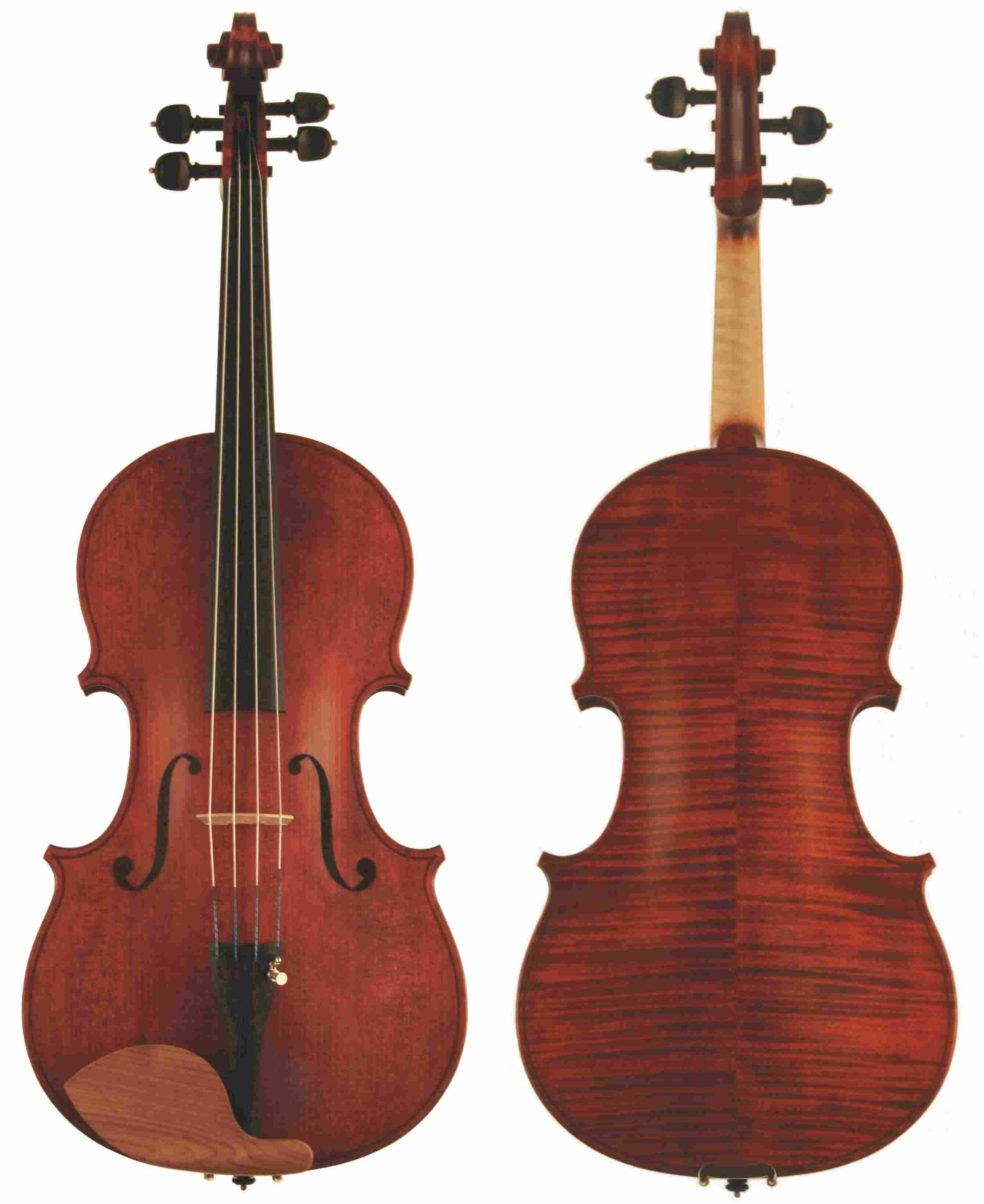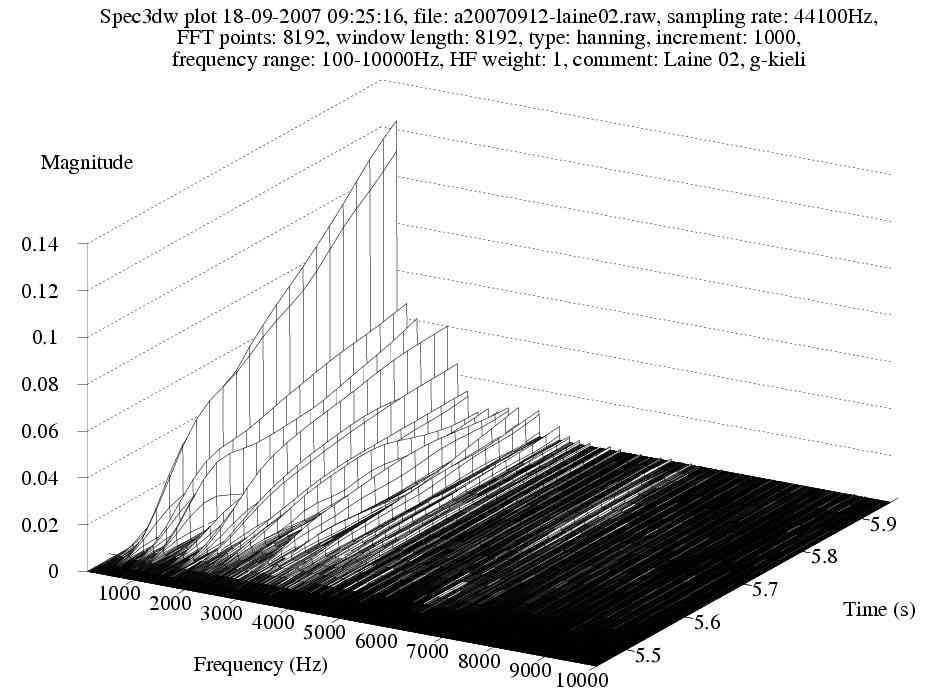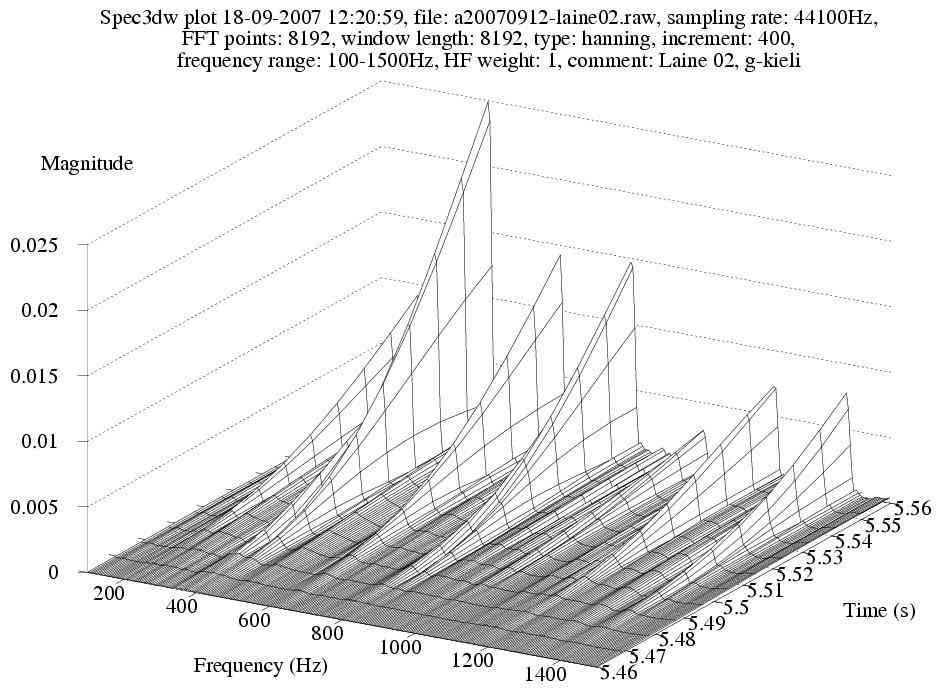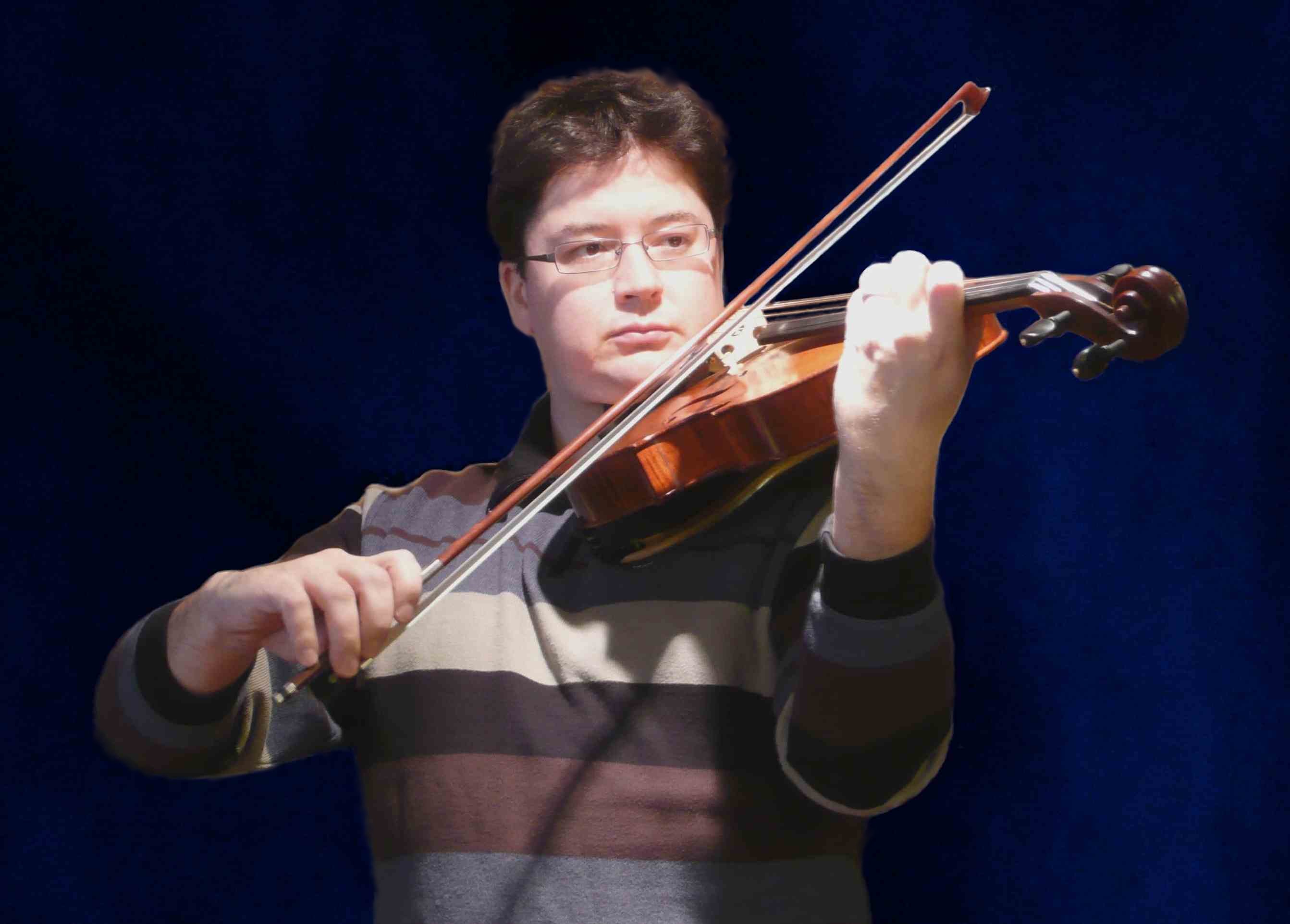
Pekka Mikael Laine
Max Savikangas
2008-03-26
English translation: Andrew Bentley

|
| The Laine viola, body size 424 mm |
On violas of standard 410-430 mm body size, the tuning of the strings is too low with respect to the size of the instrument. In many instruments, this leads to a sound which is too quiet and has too slow an attack. The timbre is often nasal, added to which the C string is quieter and the A string brighter than the others. Over the years, attempts have been made to improve the viola sound by either lengthening or widening the body, or by increasing the internal volume through an increase in the height of the sides. A viola of large dimensions is difficult to handle, however, and these experiments based on dimensions have not led to a satisfactory solution to the viola's tonal problems.
In studio recording the low volume of the viola is not a problem; however, with the growth in size of orchestras and performance venues and greater demands placed on the volume of solo instruments in an acoustical context, a larger volume and clarity is desirable.
Pekka Laine and Max Savikangas begun their project of improving the viola in 1999. The aim was to find out whether the traditional problems of the viola could be solved by applying a new varnishing technique developed by Pekka Laine and also to find out what a viola made with this varnishing technique would sound like. In the Laine varnishing technique, the wood and varnish layers of the belly form a composite structure, in which damping of vibrations at the layer boundaries is kept to a minimum, leading in turn to a louder sound.
The work begun with the building of two violas of body size 411 mm. Samples of music were recorded on these instruments in a good acoustic. The open strings of the instruments were also recorded. Evaluation of the instruments took place by listening to the samples of music and by computer analysis of the open strings.
After comparing the instruments the belly of the least good instrument was removed and replaced by one with a different thickness or shape, then the comparison was repeated. Step by step this comparison helped us find an instrument with a better sound. The bellies required very precise shaping: if the shape deviated by more than 1/4 mm from the intended design the tone changed noticeably. The bellies were shaped using a custom built machine mill, since the inaccuracy of shaping by hand would have made a comparison impossible. A further observation was that the best material for the belly came from a spruce with widely spaced but contrasting growth rings, which made the material stiff along its length but flexible across its width.
The new viola model with body length 424 mm came to fruition in spring 2002. The chief characteristics of its sound are a responsive attack and a warm, deep, but at the same time bright and clear tone. The sound is appropriately placed between the cello and violin, and the instrument does not suffer from nasality. In subsequent tests where four new Laine violas were compared with the same number of violas from other makers, it was noticed that the loudness of the Laine viola was as much as 3 dB greater that of the other instruments.
In evaluating the sound of the open strings, a computer program called Spectutils written by Kai Lassfolk and Jaska Uimonen of the Helsinki University was used. The program is based on the Fast Fourier Transform (FFT). The program allows us to see the spectral components of the sound and its attack in visual form. The sound is displayed on a 3-dimensional graph, whose axes are frequency, time and magnitude.
The data displays of different notes reveal details that are difficult or impossible to hear with a human ear, e.g. the overtone structure with the strengths of the individual overtones, the speed of the attacks and the changes in loudness. The display data are documents of recorded sound in which various factors, such as room acoustics, strings and bow, play their own part.

|

|
| Pekka Mikael Laine 1/2002 viola, G string |
A difficult but important question is how to define perfect and imperfect tone. An imperfect tone can be identified as variations in timbre and/or loudness at different pitches. Characteristics of a perfect, "neutral" tone are even frequency response throughout the register of the instrument, evenness or regularity in the spectra of individual pitches and a similar attack envelope on all strings. In other words the tone should not have formants or emphasis in any part of the spectrum. In practice this is never true. Some highly valued string instruments are famous for the individuality of their tone or "timbre". However, the frequency response of these instruments can be very uneven.
One thing that good string instruments have in common is an overtone series with a fast and strong attack reaching up to higher frequencies. If the attack of the overtones is slow, the tone colour and loudness in fast passages is affected. A certain inharmonicity in the overtone series enrichens the tone and makes it more rounded. A spectrum which reaches higher overtones adds loudness and dynamic range to the instrument by virtue of increasing energy.
The Laine viola has a neutral tone. It is possible to use strings made of different materials and the differences between string types are clearly audible. The player is free to choose his or her string type on the basis of playing requirements, musical style or personal preference.
Metal strings (e.g. Pirastro Permanent) have a tone which is precise, stable and loud to the player's ear, with a fast attack response. The variety of tonal expression is somewhat limited. The player may get the feeling that the string speaks or does not to speak, with no shades in between. Strings tolerate very forceful use of the bow without the tone breaking up, albeit that the tone is then harsh. Metal strings demand stamina from the bow arm.
Synthetic strings (e.g. D'Addario Zyex) used on the Laine viola have a wider range of tonal nuances than metal strings and a greater variety of attacks is possible. The tone at the player's ear is loud. The pitch is more diffuse. Synthetic strings suite a wide variety of musical styles. However, they do not stand up very forceful bowing without the tone breaking up.
Gut strings (e.g. Pirastro Eudoxa) used on the Laine viola offer a greater variety of tonal nuances compared with other string types. The playability is greater. The loudness at the player's ear is not so great, but the tone carries very clearly to the audience. The efficiency of the Laine viola makes it possible to use gut strings without projection problems. Due to the structure of gut strings, the tone is not necessarily as even as with other string types.
Having played the Laine viola professionally for five years I have noticed that my playing technique has become more sensitive, supple and relaxed. The efficiency on the instrument has brought advantages to me as a soloist or, for example, in quartet playing. The sound carries well and one does not run out of volume even in the loudest passages. The tone remains pleasant even when playing fortissimo and does not become howling or strident. In normal playing it helps the player physically when one doesn't have to force the sound.
Tone colour is especially important in contemporary music. If the instrument is not neutral enough, it is impossible to get a great variety of tone colours from it. This can happen if the instrument is too hollow and booming, too nasal or strident. The instrument should also allow the most peculiar playing techniques.
The Laine viola's neutral tone and excellent efficiency allows me more room for manoeuvre with respect to tone colour and dynamics. One does not have to use excessive pressure to get sound out of the instrument. To get volume, one can use bow speed, and a surprising amount of volume comes out! The same can be said of different bowing techniques; the instrument is responsive of all different kinds of bowing, such as détaché, spiccato, martelé or jeté.
I rather prefer the sound of gut strings on the Laine viola. With them the Laine viola sounds the closest to how I imagine a viola should sound, even when compared to all the other violas I have played. When I play this instrument I get closest to reaching the tonal nuances and articulations I have in mind, in other words my musical intentions. What inspiring flexibility!
One of the most important demands on the present-day viola seems to be versatility, because the type of music being played, the instrumentation of ensembles and the acoustic of performing venues all vary a great deal. On the basis of our experiences working with it, the new design of viola described here seems to rise to these challenges and suits the performance of modern music particularly well, since it is here that loud volume, wide dynamic range, mobility and a wide range of timbral possibilities come into their own.
The project to design a new viola achieved its goals. It was possible to make clear improvements in many areas of sound and playability. The tone of the new viola is now on a par with that of the violin and cello.
Max Savikangas: Song of the Blissful for viola solo (1994), extract.
Max Savikangas, viola.
Instrument: "Pekka Mikael Laine 1/2002", recording made in 2003:
Max Savikangas: Song of the Blissful for viola solo (1994), extract (mp3)
Max Savikangas: Death at Work for viola solo (1997), extract.
Max Savikangas, viola.
Instrument: "Pekka Mikael Laine 1/2002", recording made in 2003:
Max Savikangas: Death at Work for viola solo (1997), extract (mp3)
Max Savikangas: Extraterrestrial for viola solo (2001), extract.
Max Savikangas, viola.
Instrument: "Pekka Mikael Laine 1/2002", recording made in 2003:
Max Savikangas: Extraterrestrial for viola solo (2001), extract (mp3)

|
| Pekka Mikael Laine is an architect by professional training. He has built string instruments since the 1980's. He established his own workshop in the mid-1990's, and since that time has worked as a professional maker of violins and violas. |

|
| Max Savikangas is a composer and viola player. He received his M.Mus. degree from the Sibelius Academy in 1998 after completing studies in theory, composition, viola and electro-acoustic music. Savikangas is a founding member of the Uusinta chamber orchestra. |